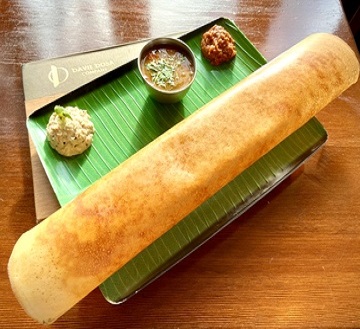So, just what is a dosa?
Strictly speaking, a dosa is a thin, crispy pancake from South India. It’s made from a batter of fermented ground lentils and rice.
In reality, it’s so much more than that. It’s a dish that has been a staple of South Indian cuisine for centuries. They can be eaten at almost any time of day, and there are endless possibilities as to what you can eat them with.
It’s a dish that can be found in pretty much all South Indian restaurants, and you’ll be pleased to know that Davie Dosa Company is no different!
A dosa comes in a variety of shapes. As well as the classic rolled style, they can be triangular or circular, or even slightly thicker if a different batter is used.
A dosa can be served with anything, from chutneys, to curries, to vegetables, to… just about anything you like really. But more on that a bit later.
For now, let’s go on a journey back in time…
The history of dosas
The dosa’s origins are up for speculation, and are something of a mystery. Some, like renowned food historian P Thankappan Nair, say the dosa was first created in the city of Udipi in Karnataka. Others claim it found its beginnings in Tamil Nadu.
Evidence for the dosa getting its start in Karnataka includes the presence of a recipe for dosa, under the name ‘dosaka’, in an encyclopedia written by Chalukya King Someshvara III, who led the state of Karnataka around 1126 CE.
Those who believe Tamil Nadu to be the birth place of the dosa state that the dish has existed in Tamil culture for centuries.
Whatever the truth is – and we may never know the whole truth – one thing is certain; the dosa is an ancient creation, and one that is beloved across South India, and the world.
Types of dosa
There are countless types of dosa, each changing according to the amounts and type of each ingredient used.
One of the most common is the masala dosa, which is the same pancake-style dish, served with potato curry, chutney and sambar.
The types of dosa you might find will change according to the region of South India you’re in. Each of the five states does it slightly differently, and that’s what makes this such a special dish.
Check out our menu to see the types of dosa we have on offer at Davie Dosa Company. Hint: it’s a lot, and they’re fully customizable!

What are dosas made of?
Like any pancake, to make a dosa you need to start with a batter. Dosa batter is made by fermenting lentils and rice, preferably overnight, but for at least four to six hours. The lentils and rice are blended with water separately until they reach a smooth, bubbly consistency, then combined, usually by hand to help with the fermentation process.
And there you have it, a dosa batter!
Just a quick note on the fermentation process; it comes with a whole load of health benefits. Fermented foods have anti-inflammatory, anti-diabetic, and anti-oxidant properties, are great for your gut, and can help to strengthen your immune system.
What’s more, the ingredient list means that dosas are rich in protein, low in fat, an excellent source of carbohydrates, and a light but filling way to start – or end – your day.
So there you have it, even more reasons to try a dosa at Davie Dosa Company.
How are dosas made?
Once the batter has been concocted, it’s time to get cooking. To ensure that delightful crispy finish, a flat, circular pan is heated up, and a little bit of oil is added. This makes sure the batter doesn’t stick to the pan, and you don’t end up with something resembling scrambled eggs (definitely not the goal here).
A ladle of batter at a time is added to the pan and spread out until it starts to resemble a thin pancake.
Once the edges of the dosa start peeling away from the pan, it’s ready to either flip and cook on the other side, or fill with a delightful selection of deliciousness.
That brings us nicely to…
What can you eat dosas with?
The world is your oyster. Although, we’re not sure what an oyster dosa would be like… give it a go and let us know what you think, if you’re brave enough!
The beauty of a dosa is that it can be eaten on its own, meaning it’s perfect for a speedy breakfast or quick snack.
For a slightly more substantial meal, delicious additions to the dosa include coconut and onion chutneys, meat, fish, seafood, eggs, cheese, curries, gravies, salads, pickles… can you see where we’re going with this?
It’s easy to see why the dosa has been such an integral part of South Indian cooking. It’s a truly versatile example of South Indian food; you can even pair dosas with sugar, jaggery (a cane sugar full of vitamins and minerals), and coconut milk to create a sweet treat.
What do dosas taste like?
To truly find out what a dosa tastes like, you’ll have to visit us at Davie Dosa Company! But for now, let’s just say that our dosas are crisp on the outside and fluffy on the inside. It’s the perfect savoury dish, breakfast choice, or snack, and though there are definitely tried and tested ways to eat them, how you enjoy a dosa is completely up to you.
We look forward to welcoming you at Davie Dosa Company soon. Which dosa are you going to try first?!




